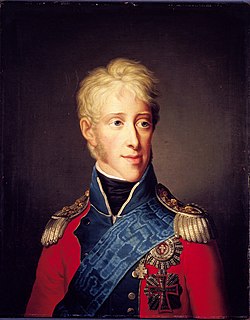
Back Frederik VI van Denemarke Afrikaans فريدريك السادس ملك الدنمارك Arabic فريدريك السادس ملك الدنمارك ARZ VI Fridrix (Danimarka kralı) Azerbaijani Фрэдэрык VI Byelorussian Фредерик VI Bulgarian Frederig VI Danmark Breton Frederic VI de Dinamarca Catalan Frederik VI. Czech Frederik 6. Danish
| Frederick VI | |
|---|---|
 Portrait by Friedrich Carl Gröger, 1808 | |
| King of Denmark | |
| Reign | 13 March 1808 – 3 December 1839 |
| Coronation | 31 July 1815 Frederiksborg Palace Chapel |
| Predecessor | Christian VII |
| Successor | Christian VIII |
| Chief Ministers | |
| King of Norway | |
| Reign | 13 March 1808 – 7 February 1814 |
| Predecessor | Christian VII |
| Successor | Christian Frederick |
| Crown Prince-Regent of Denmark-Norway | |
| Tenure | 14 April 1784 – 13 March 1808 |
| Predecessor | Hereditary Prince Frederick |
| Monarch | Christian VII |
| Born | 28 January 1768 Christiansborg Palace, Copenhagen |
| Died | 3 December 1839 (aged 71) Amalienborg Palace, Copenhagen |
| Burial | |
| Spouse | |
| Issue | Caroline, Hereditary Princess of Denmark Vilhelmine, Duchess of Schleswig-Holstein-Sonderburg-Glücksburg |
| House | Oldenburg |
| Father | Christian VII of Denmark |
| Mother | Caroline Matilda of Great Britain |
| Signature | |
Frederick VI (Danish and Norwegian: Frederik; 28 January 1768 – 3 December 1839) was King of Denmark from 13 March 1808 until his death in 1839 and King of Norway from 13 March 1808 to 7 February 1814. He was the last king of Denmark–Norway. From 1784 until his accession, he served as regent during his father's mental illness and was referred to as the "Crown Prince Regent" (Norwegian: kronprinsregent). For his motto he chose God and the just cause (Danish: Gud og den retfærdige sag). Instead of the customary latin, he used Danish, which established a precedent for later Danish kings who used Danish as well.[1][2]
Born in Christiansborg Palace, Copenhagen,[3] Frederick VI was the eldest of two children and the only son of Christian VII and Caroline Mathilde.[4] In 1790, Frederick VI married Marie Sophie. Together, they had eight children, though only two daughters, Princess Caroline and Princess Wilhelmine, survived to adulthood. Additionally, He was the last Danish king to have an official mistress, Frederikke Dannemand, with whom he had five children.
His reign as regent is highlighted by the abolition of serfdom, the end of hanging as a capital punishment in the kingdom, and the withdrawal of Dano-Norwegian involvement in the transatlantic slave trade. Other significant events during his time as regent include the Battle of Copenhagen of 1801 and the Battle of Copenhagen of 1807.[5] His later reign as king is highlighted by his patronage of astronomy, the introduction of primary schools, the creation of the Assemblies of Estate, and the ensurement of full civil rights to the Jews. Other significant events during his reign as king include the end of the Napoleonic Wars, the Congress of Vienna, the loss of Norway, and an economic depression.
With no surviving legitimate sons, Frederick VI was succeeded by his half-cousin, Christian.
- ^ "British Survey Handbooks, Denmark". Retrieved 21 December 2015.
- ^ "kronprinsregent". Store norske leksikon. Retrieved 4 November 2012.
- ^ "Kongelige i kirkebøgerne" [Royals in the church records]. historie-online.dk (in Danish). Dansk Historisk Fællesråd. Archived from the original on 24 September 2015. Retrieved 18 February 2013.
- ^ Jensen 1935, p. 256.
- ^ Magne Njåstad. "Flåteranet i 1807". Store norske leksikon. Retrieved 15 August 2016.
© MMXXIII Rich X Search. We shall prevail. All rights reserved. Rich X Search